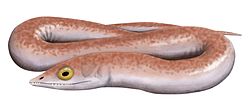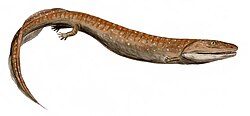| Palaeospondylus Temporal range: | |
|---|---|
 | |
| Fossil on display at the Cincinnati Museum Center | |
| Scientific classification | |
| Kingdom: | |
| Phylum: | |
| Subphylum: | |
| Infraphylum: | |
| Genus: | †Palaeospondylus Traquair, 1890 |
| Type species | |
| Palaeospondylus gunniTraquair, 1890 | |
Palaeospondylus ("early vertebra") is a prehistoric fish, a fossil vertebrate. Its fossils were originally described from the Achanarras slate quarry in Caithness, Scotland, and a second species has been discovered in Australia. [1]
Contents
The Scottish fossil as preserved is carbonised, and indicates an eel-shaped animal up to 6 centimetres (2 in) in length. The skull, which must have consisted of hardened cartilage, exhibits pairs of nasal and auditory capsules, with a gill apparatus below its hinder part, and ambiguous indications of ordinary jaws. [2]

The phylogeny of this fossil has puzzled scientists since its discovery in 1890, and many taxonomies have been suggested. In 2004, researchers proposed that Palaeospondylus was a larval lungfish. [3] Previously, it had been classified as a larval tetrapod, unarmored placoderm, an agnathan, an early stem hagfish, and a chimaera. [4] [5] A 2017 study suggested that it was a stem chondrichthyan. [6]
In 2022, researchers reported, based on studies using synchrotron radiation X-ray micro-computed tomography, that the neurocranium of Palaeospondylus was similar to those of the stem-tetrapods Eusthenopteron and Panderichthys , and concluded that Palaeospondylus was between those two phylogenetically. [7] Brownstein (2023) criticized this study, suggesting it would be basal gnathostomes instead. [8] Hirasawa and Kuratani, who are authors in 2022 study, replied to that and reviewed phylogeny again, resulted it would be closer to Acanthostega instead. [9] The 2024 study, using braincase data, ruled out the tetrapod hypothesis. [1]





